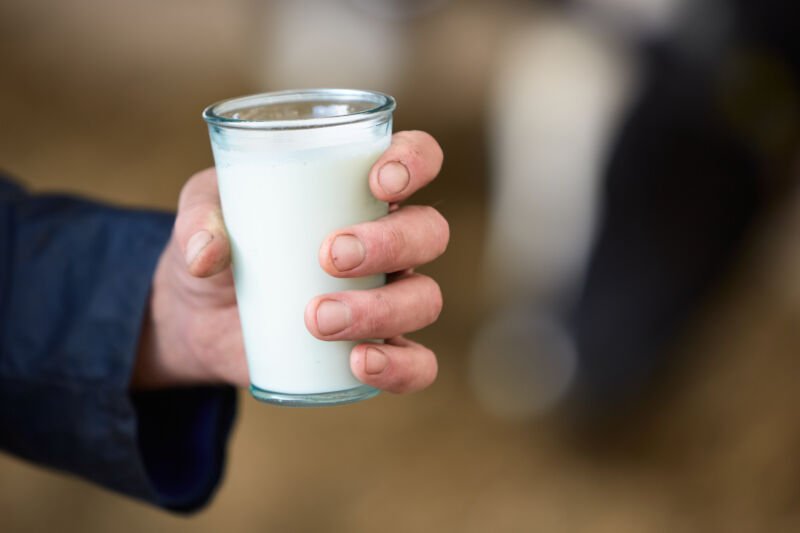
To drink raw milk at any time is to flirt with dangerous germs. But, amid an unprecedented outbreak of H5N1 bird flu in US dairy cows, the risks have ratcheted up considerably. Health experts have stepped up warnings against drinking raw milk during the outbreak, the scope of which is still unknown.
Yet, raw milk enthusiasts are undaunted by the heightened risk. The California-based Raw Milk Institute called the warnings “clearly fearmongering.” The institute’s founder, Mark McAfee, told the Los Angeles Times this weekend that his customers are, in fact, specifically requesting raw milk from H5N1-infected cows. According to McAfee, his customers believe, without evidence, that directly drinking high levels of the avian influenza virus will give them immunity to the deadly pathogen.
Expert Michael Payne told the LA Times that the idea amounts to “playing Russian roulette with your health.” Payne, a researcher and dairy outreach coordinator at the Western Institute for Food Safety and Security at UC Davis, added that “Deliberately trying to infect yourself with a known pathogen flies in the face of all medical knowledge and common sense.”
Much remains unknown about the biology of avian influenza in cattle. Until March 25, when the US Department of Agriculture confirmed the virus in a dairy herd in Texas, cattle were generally considered virtually resistant to H5N1. But since then, the USDA has tallied 42 herds in nine states that have contracted the virus. Epidemiological data so far suggests that there has been cow-to-cow transmission following a single spillover event and that the 42 outbreak herds are connected by the movement of cattle between farms.
The limited data on the cows so far suggests that the animals largely develop mild illness from the infection and recover in a few weeks. Their mammary glands are the primary target of the virus. A preprint published earlier this month found that cows’ udders are rife with the molecular receptors that bird flu viruses latch onto to spark an infection. Moreover, the glands contain multiple types receptors, including ones targeted by human flu viruses as well as those targeted by bird flu viruses. Thus, dairy cows could potentially act as a mixing vessel for the different types of flu viruses to reassemble into new, outbreak-sparking variants.
With the virus apparently having a field day in cows’ udders, researchers have found raw milk to be brimming with high levels of H5N1 viral particles—and those particles appear readily capable of spilling over to other mammals. In a case study last month, researchers reported that a group of about two dozen farm cats developed severe illness after drinking milk from H5N1-infected cows. Some developed severe neurological symptoms. More than half the cats died in a matter of days.
Deadly virus
Data on flu receptors in the two animals may explain the difference between cows and cats. While the cow’s mammary gland had loads of multiple types of flu receptors, those receptors were less common in other parts of the cow, including the respiratory tract and brain. This may explain why they tend to have a mild infection. Cats, on the other hand, appear to have receptors more widely distributed, with infected cats showing viral invasion of the lungs, hearts, eyes, and brains.
Raw milk devotees—who claim without evidence that drinking raw milk provides health benefits over drinking pasteurized milk—dismiss the risk of exposure to H5N1. They confidently argue—also without evidence—that the human digestive system will destroy the virus. And they highlight that there is no documented evidence of a human ever becoming infected with H5N1 from drinking tainted milk.
The latter point on the lack of evidence of milkborne H5N1 transmission is true. However, the current outbreak is the first known spillover of highly pathogenic avian influenza (HPAI) to dairy cow mammary glands. As such, it presents the first known opportunity for such milk-based transmission to occur.
Before pasteurization became routine for commercial milk production, raw milk was a common source of infections, serving up a cornucopia of germs. According to the FDA, in 1938, milkborne outbreaks accounted for 25 percent of all foodborne disease outbreaks. In more recent times, milk has been linked to less than 1 percent of such outbreaks. The Centers for Disease Control and Prevention notes that areas where raw milk was sold legally between 1998 and 2018 had 3.2 times more outbreaks than areas where the sale of raw milk was illegal.
In a Q&A document, the Food and Drug Administration notes that “we do not know at this time if HPAI A (H5N1) viruses can be transmitted through consumption of unpasteurized (raw) milk and products (such as cheese) made from raw milk from infected cows.” However, the agency goes on, because of that lack of data and the potential for infection, the FDA recommends halting all sales of raw milk and raw milk products from H5N1 infected or exposed cattle. In general, the agency recommends against consuming raw milk.
Globally, as of March 28, there have been 888 cases of H5N1 reported in humans in 23 countries. Of those 888 cases, 463 were fatal. That represents a 52 percent fatality rate, however it’s possible that there are asymptomatic or undiagnosed cases that could alter that rate. In the US, only one human so far is known to have been infected with H5N1 in connection with the dairy cow outbreak—a farm worker who developed pink eye. The man had no respiratory symptoms and recovered. He did not consent to further follow-up, and researchers did not get consent to test the man’s household contacts to see if they, too, were infected.




















+ There are no comments
Add yours